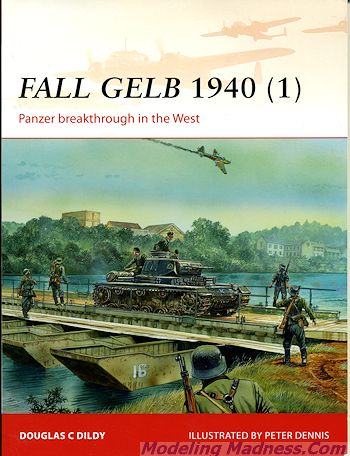Osprey's Fall Gelb 1940 (1)
|
Author: |
Douglas Dildy, illustrated by Peter Dennis |
|
Publisher/Distributor |
Osprey Publishing |
|
Price |
$21.95 MSRP |
|
Reviewer: |
Scott Van Aken
|
|
Notes: |
96 pages, 7¼ x 9¼ inches, softcover
ISBN:978-1-78200-644-2 |
 Fall
Gelb (Case Yellow) was the plan for invading Holland, Belgium and France in
1940. After assessing the invasion of Poland and allowing units to reequip if
needed and to replace losses, Hitler and his generals needed to plan for
expanding westward. It was pretty obvious that the French and the British were
not going to make any moves on Germany so the only way to continue the war was
for German forces to take the initiative.
Fall
Gelb (Case Yellow) was the plan for invading Holland, Belgium and France in
1940. After assessing the invasion of Poland and allowing units to reequip if
needed and to replace losses, Hitler and his generals needed to plan for
expanding westward. It was pretty obvious that the French and the British were
not going to make any moves on Germany so the only way to continue the war was
for German forces to take the initiative.
Like all plans, the
ones for Case Yellow ere modified time and time again as commanders provided
input and the strengths and weaknesses of the enemy were evaluated. It was
pretty well assumed that the Belgians and Dutch would not be capable of stopping
the German Army, especially after the Luftwaffe gained control of the air. For
sure there were areas where the going would be difficult, such as getting around
the forts of Eban Emael in Belgium, but the main concern was the French.
On paper, the French
had an army that was superior to that of the Germans. However, the French still
thought in terms of WWI tactics and strategy whereas the Germans had embraced a
strategy of a hard initial punch at one area and then swift movement using their
tanks and motorized infantry. It was important to get across the Meuse River as
that was a major waterway. Once across that, the way would be open to head north
to the Channel in order to trap Allied troops. It also left open the way to the
Atlantic coast and south towards Paris.
In this first volume, author Douglas
Dildy provides a look at this first part of this campaign from the initial
planning, through the various changes and finally into implementation. As is
frequent with plans, they never seem to go exactly as one wishes, but in this
case for the most part, they went better than hoped for the Germans and not as
well as desired by the defenders. The Germans had difficulty holding back some
of its panzer generals while the French had their issues holding units together
under the onslaught. Once it became obvious that the Germans could not be
stopped, units started to retreat. Some in an orderly fashion and others, well,
less organized. The RAF pulled out early as losses became more than they could
handle. Allied bombing was generally ineffective and while fighters had
relatively good success, it was not enough and eventually they were worn down as
attrition took its toll.
Eventually the Allies were either being
routed to the south towards Paris or into a ever closing pocket around Dunkirk,
and this is where this volume ends. It all makes for a great read and thanks to
the fine selection of period photos and the art work and maps of Peter Dennis,
it becomes more understandable to the reader. I very much enjoyed the book and
look forward to the second volume.
September 2014
For more on the complete line of Osprey books,
visit http://ospreygrp.com. In the US, it is
Osprey Direct at 44-02 23rd St, Suite 219, Long Island City, NY 11101., where you can
get a catalogue of available books.
If you would like your product reviewed fairly and fairly quickly, please
contact
the editor or see other details in the
Note to
Contributors.
 Fall
Gelb (Case Yellow) was the plan for invading Holland, Belgium and France in
1940. After assessing the invasion of Poland and allowing units to reequip if
needed and to replace losses, Hitler and his generals needed to plan for
expanding westward. It was pretty obvious that the French and the British were
not going to make any moves on Germany so the only way to continue the war was
for German forces to take the initiative.
Fall
Gelb (Case Yellow) was the plan for invading Holland, Belgium and France in
1940. After assessing the invasion of Poland and allowing units to reequip if
needed and to replace losses, Hitler and his generals needed to plan for
expanding westward. It was pretty obvious that the French and the British were
not going to make any moves on Germany so the only way to continue the war was
for German forces to take the initiative.